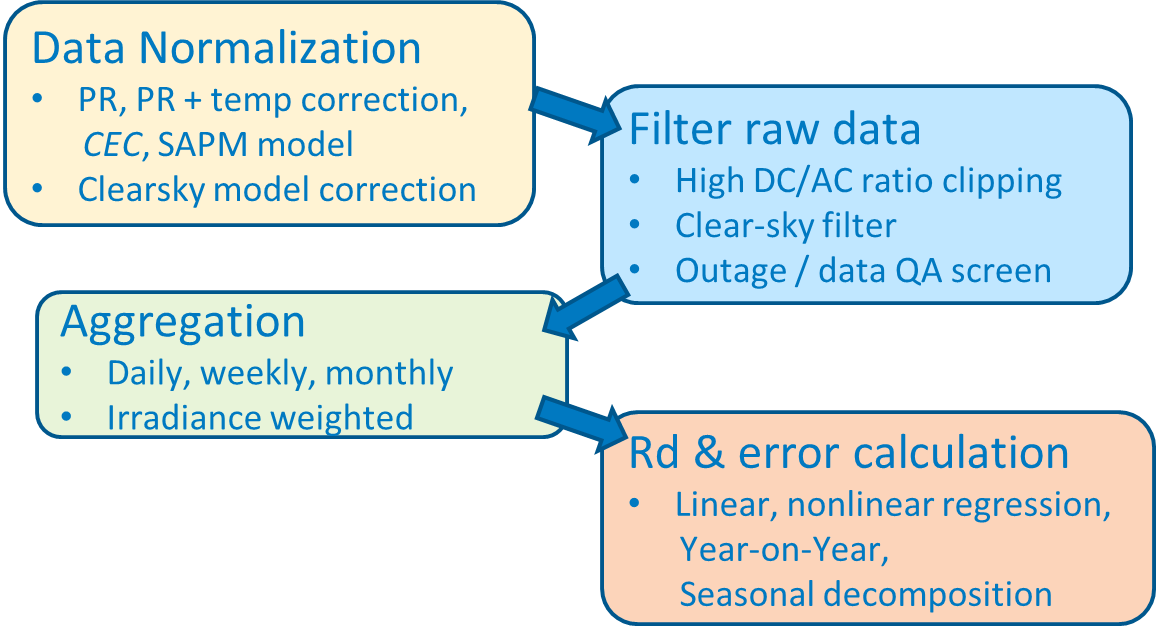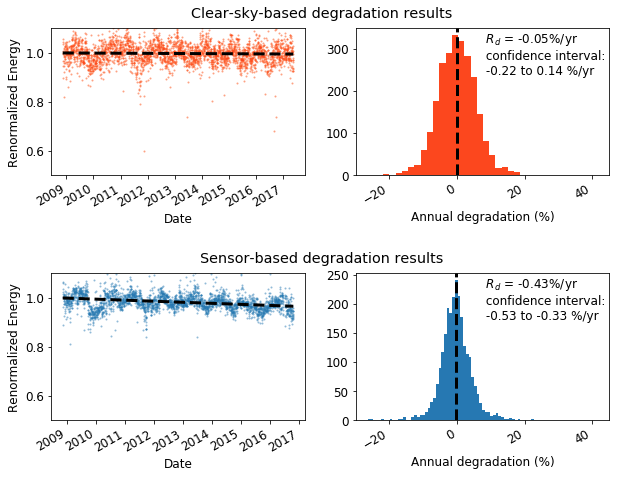Master branch:
Development branch:
RdTools is a set of Python tools for analysis of photovoltaic data. In particular, PV production data is evaluated over several years to obtain rates of performance degradation over time. RdTools can handle both high frequency (hourly or better) or low frequency (daily, weekly, etc.) datasets. Best results are obtained with higher frequency data.
Full examples are worked out in the example notebooks in rdtools/docs.
- Import and preliminary calculations
- Normalize data using a performance metric
- Filter data that creates bias
- Aggregate data
- Analyze aggregated data to estimate the degradation rate
The preferred method for degradation rate estimation is the year-on-year (YOY) approach,
available in degradation.degradation_year_on_year. The YOY calculation yields in a distribution
of degradation rates, the central tendency of which is the most representative of the true
degradation. The width of the distribution provides information about the uncertainty in the
estimate via a bootstrap calculation. The example notebook uses the output of degradation.degradation_year_on_year()
to visualize the calculation.
Two workflows are available for system performance ratio calculation, and illustrated in an example notebook. The sensor-based approach assumes that site irradiance and temperature sensors are calibrated and in good repair. Since this is not always the case, a 'clear-sky' workflow is provided that is based on modeled temperature and irradiance. Note that site irradiance data is still required to identify clear-sky conditions to be analyzed. In many cases, the 'clear-sky' analysis can identify conditions of instrument errors or irradiance sensor drift, such as in the above analysis.
RdTools can be installed automatically into Python from PyPI using the command line:
pip install rdtools
Alternatively it can be installed manually using the command line:
- Download a release (Or to work with a development version, clone or download the rdtools repository).
- Navigate to the repository:
cd rdtools - Install via pip:
pip install .
On some systems installation with pip can fail due to problems installing requirements. If this occurs, the requirements specified in setup.py may need to be separately installed (for example by using conda) before installing rdtools.
RdTools currently runs in both Python 2.7 and 3.6.
Full workflow examples are found in the notebooks in rdtools/docs. The examples are designed to work with python 3.6. For a consistent experience, we recommend installing the packages and versions documented in docs/notebook_requirements.txt. This can be achieved in your environment by first installing RdTools as described above, then running pip install -r docs/notebook_requirements.txt from the base directory.
The following functions are used for degradation analysis:
import rdtools
The most frequently used functions are:
normalization.normalize_with_pvwatts(energy, pvwatts_kws)
'''
Inputs: Pandas time series of raw energy, PVwatts dict for system analysis
(poa_global, P_ref, T_cell, G_ref, T_ref, gamma_pdc)
Outputs: Pandas time series of normalized energy and POA insolation
'''filtering.poa_filter(poa); filtering.tcell_filter(Tcell); filtering.clip_filter(power);
filtering.csi_filter(insolation, clearsky_insolation)
'''
Inputs: Pandas time series of raw data to be filtered.
Output: Boolean mask where `True` indicates acceptable data
'''aggregation.aggregation_insol(normalized, insolation, frequency='D')
'''
Inputs: Normalized energy and insolation
Output: Aggregated data, weighted by the insolation.
'''degradation.degradataion_year_on_year(aggregated)
'''
Inputs: Aggregated, normalized, filtered time series data
Outputs: Tuple: `yoy_rd`: Degradation rate
`yoy_ci`: Confidence interval `yoy_info`: associated analysis data
'''The underlying workflow of RdTools has been published in several places. If you use RdTools in a published work, please cite the following:
- D. Jordan, C. Deline, S. Kurtz, G. Kimball, M. Anderson, "Robust PV Degradation Methodology and Application", IEEE Journal of Photovoltaics, 2017
- RdTools, version x.x.x, https://github.com/NREL/rdtools, DOI:10.5281/zenodo.1210316
(be sure to include the version number used in your analysis)
The clear sky temperature calculation, clearsky_temperature.get_clearsky_tamb(), uses data
from images created by Jesse Allen, NASA’s Earth Observatory using data courtesy of the MODIS Land Group.
https://neo.sci.gsfc.nasa.gov/view.php?datasetId=MOD_LSTD_CLIM_M
https://neo.sci.gsfc.nasa.gov/view.php?datasetId=MOD_LSTN_CLIM_M
Other useful references which may also be consulted for degradation rate methodology include:
- D. C. Jordan, M. G. Deceglie, S. R. Kurtz, “PV degradation methodology comparison — A basis for a standard”, in 43rd IEEE Photovoltaic Specialists Conference, Portland, OR, USA, 2016, DOI: 10.1109/PVSC.2016.7749593.
- Jordan DC, Kurtz SR, VanSant KT, Newmiller J, Compendium of Photovoltaic Degradation Rates, Progress in Photovoltaics: Research and Application, 2016, 24(7), 978 - 989.
- D. Jordan, S. Kurtz, PV Degradation Rates – an Analytical Review, Progress in Photovoltaics: Research and Application, 2013, 21(1), 12 - 29.
- E. Hasselbrink, M. Anderson, Z. Defreitas, M. Mikofski, Y.-C.Shen, S. Caldwell, A. Terao, D. Kavulak, Z. Campeau, D. DeGraaff, “Validation of the PVLife model using 3 million module-years of live site data”, 39th IEEE Photovoltaic Specialists Conference, Tampa, FL, USA, 2013, p. 7 – 13, DOI: 10.1109/PVSC.2013.6744087.
Check out the wiki for additional usage documentation, and for information on development goals and framework.

